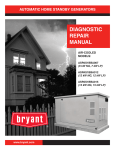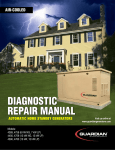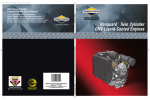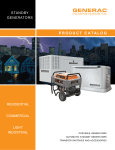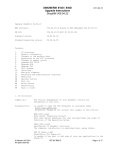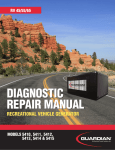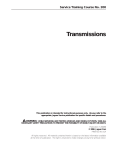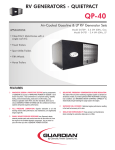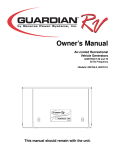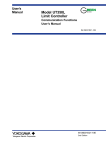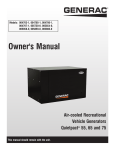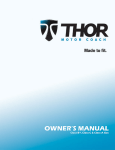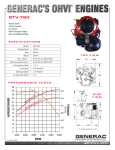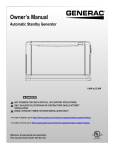Download SERVICE MANUAL
Transcript
Manual Part No. 0C8221 SERVICE MANUAL GN724 V-T TWIN OHVI ENGINE P. O. B o x 2 9 7 • W h i t e w a t e r, W I • 5 3 1 9 0 Phone: (262) 473-5514 Fax: (262) 472-6505 Printed in U.S.A First Edition Issued - 051001 FOREWORD This manual has been written and published by GENERAC® POWER SYSTEMS, INC. to aid our dealers’ mechanics, company service personnel and general consumers when servicing the products described herein. It is assumed that these personnel are familiar with the servicing procedures for these products, or like or similar products, manufactured and marketed by GENERAC® POWER SYSTEMS, INC. It is also assumed that they have been trained in the recommended servicing procedures for these products, which includes the use of mechanics hand tools and any special tools that might be required. Proper service and repair is important to the safe, economical and reliable operation of the products described herein. The troubleshooting, testing, service and repair procedures recommended by GENERAC® POWER SYSTEMS, INC. and described in this manual are effective methods of performing such operations. Some of these operations or procedures may require the use of specialized equipment. Such equipment should be used when and as recommended. We could not possibly know of and advise the service trade of all conceivable procedures or methods by which a service might be performed, nor of any possible hazards and/or results of each procedure or method. We have not undertaken any such wide evaluation. Therefore, anyone who uses a procedure or method not recommended by the manufacturer must first satisfy himself that neither his safety, nor the product’s safety, will be endangered by the service or operating procedure selected. All information, illustrations and specifications contained in this manual are based on the latest product information available at the time of publication. However, GENERAC® POWER SYSTEMS, INC. reserves the right to change, alter or otherwise improve the product at any time without prior notice. Some components or assemblies of the product described in this manual may not be considered repairable. Disassembly, repair and reassembly of such components may not be included in this manual. The engines described herein may be used to power a wide variety of products. Service and repair instructions relating to any such products are not covered in this manual. For information pertaining to use of these engines with other products, refer to any owner’s or service manuals pertaining to said products. TABLE OF CONTENTS 4-CYCLE ENGINE THEORY .................................................................................................................................. 4 SECTION 1: GENERAL INFORMATION................................................................................................................ 5 SECTION 2: IGNITION ........................................................................................................................................ 10 SECTION 3: GOVERNOR .................................................................................................................................. 14 SECTION 4: CYLINDER HEAD AND VALVES .................................................................................................... 18 SECTION 5: ELECTRIC STARTERS ........................................................................................................................................ 24 SECTION 6: LUBRICATION SYSTEM ................................................................................................................ 30 SECTION 7: ENGINE DISASSEMBLY.................................................................................................................. 35 SECTION 8: CYLINDER AND CRANKCASE INSPECTION AND REPAIR ............................................................ 37 SECTION 9: CRANKSHAFT AND CAMSHAFT .................................................................................................. 41 SECTION 10: PISTON, RINGS AND CONNECTING ROD INSPECTION AND ASSEMBLY .................................. 42 SECTION 11: ENGINE ASSEMBLY .................................................................................................................... 45 A WORD ABOUT SPECIAL TOOLS Many of the procedures depicted in this manual require the use of special tools. Some of the tools required are available as Generac parts and are listed as such in this manual. Other tools are listed only as Briggs & Stratton parts and must be acquired through a Briggs & Stratton source of supply. Portions of this manual have been reprinted from Briggs & Stratton P/N 273521-4/98 “Repair Manual For Intek™ V-twin Cylinder OHV Engines” with permission from Briggs & Stratton. All rights are reserved ATTENTION! Generac Power Systems does not approve or authorize the use of these engines on All Terrain Vehicles (ATV”s), go-carts, motorbikes, aircraft products, personal watercraft, or vehicles intended for use in competitive events. Use of these engines in such applications could result in property damage, serious injury (including paralysis), or even death. 1 NOTES 2 If you don't understand any portion of this manual, contact an authorized Generac service dealer. Throughout this publication, DANGER, WARNING and CAUTION blocks are used to alert you to special instruction about a particular operation that may be hazardous if performed incorrectly or carelessly. Observe them carefully. These safety warnings cannot eliminate the hazards that they indicate. Strict compliance with the special instructions while performing the service plus "common sense" are major measures to prevent accidents. The following definitions apply to DANGER, WARNING, CAUTION and NOTE blocks found throughout the manual. DANGER: After this heading you can read handling, installing, operating or servicing instructions that, if not strictly complied with, will result in personal injury. WARNING: After this heading you can read handling, installing, operating or servicing instructions that, if not strictly complied with, may result in personal injury. CAUTION: After this heading you can read instructions for handing, installing, operating or servicing the engine that, if not strictly complied with, may result in damage to equipment and/or property. NOTE: After this heading you can read explanatory statements that require special emphasis. 3 4-CYCLE ENGINE THEORY If the engine is to run properly, four (4) events must occur in the proper sequence and at the correct time. These events are (a) intake, (b) compression, (c) ignition and power, and (d) exhaust. C IGNITION AND POWER By the time the piston reaches TDC , combustion is already in progress. The intake and exhaust valves remain closed as the expanding gases of combustion force the piston downward. A INTAKE The piston is travelling from top dead center (TDC) to bottom dead center (BDC). The cam has opened the intake valve. The piston's downward movement in the cylinder creates a partial vacuum in the cylinder. Air at atmospheric pressure is drawn into the cylinder through the carburetor and is mixed with fuel in the carburetor. The fuel-air mixture flows through the open intake valve into the cylinder. When the piston reaches BDC, the intake stroke is over. D EXHAUST The exhaust stroke begins when the piston has reached BDC and has started its upward movement. The intake valve is closed. The exhaust valve is open to let gases escape. B COMPRESSION As the piston reaches bottom dead center (BDC), both the intake and exhaust valves are closed. The piston moves upward toward TDC and the fuel-air mixture is compressed. Just before the piston reaches TDC, ignition occurs. 4 SECTION 1: GENERAL INFORMATION Purpose and Scope of Manual This manual contains all information normally required to service or repair the Model GN-724 V-twin engine. Applicable procedures are carefully explained and illustrated. For exploded views and listings of engine parts, refer to the Owner's Manual for the specific device on which the engine is used. When ordering parts, always include the model and serial number of the engine. Be sure to insist on genuine Generac repair parts. Systematic Check If the engine will not start and the cause of malfunction is not readily apparent, perform a systematic check in the following order: Fig. 6 - Running Check Check Ignition (Fouled Plug or Other Causes) 1. Ignition 2. Fuel To check for a fouled spark plug or a non-functioning cylinder, attach the spark tester (Generac P/N 0C5969) between the spark plug lead and each spark plug. Start and run engine at top no load speed. Now ground one spark plug, Fig. 7. The engine should continue to run on the other cylinder. Repeat this test with the other cylinder. If the engine will not continue to run when making this test, the cylinder that is NOT grounded is not functioning and/or the spark plug is fouled. Install a new spark plug before proceeding. If miss continues, problem may be carburetion or compression. See Check Carburetion, Check Compression. Also see Cylinder Balance Test. 3. Compression This check-up, performed in a systematic manner, can usually be done in a matter of minutes. It is the quickest and surest method of determining the cause of failure. The basic checkup procedure is the same for all engine models, while any variation, by model, will be shown under the subject heading. Check Ignition If spark does not occur look for • Two closed diodes in ground wire harness • Incorrect armature air gap • Armature failure • Shorted wire #18 Check Ignition (Engine Running) If engine runs but misses during operation, a quick check to determine if ignition is or is not at fault can be made by installing a spark tester (Generac P/N 0C5969) between the spark plug lead and each spark plug, Fig. 6. A spark miss will be readily apparent when the engine is running. If spark is good but engine misses, check for a fouled spark plug. Fig. 7 - Checking For Fouled Plugs 5 SECTION 1: GENERAL INFORMATION Tools Required: Check Fuel The fuel pressure can be checked using a pressure tester kit (Generac P/N 0C7977). This kit comes with an informative “How To” video. 1. Two Ignition Testers (Generac P/N 0C5969) 2. Screwdriver with insulated handle Attach an ignition tester between the spark plug lead and each spark plug, Fig. 8. Check Compression It has been determined through testing, a simple and accurate indication of compression can be made as follows: Remove both spark plugs and insert a compression gauge into either cylinder (one cylinder at a time). Turn engine over with engine starter until there is no further increase in pressure. Record this reading. Repeat procedure on other cylinder and record that reading. The difference between both cylinders should not exceed 25%. More than 25% indicates loss of compression in the cylinder with lower pressure. See example. EXAMPLE: Eng. #1 Eng. #2 Fig. 8 Cyl. #1 65 PSI 75 PSI Cyl. #2 60 PSI 55 PSI Diff. 5 PSI 20 PSI % Diff. 7.6% 26.7% If compression is poor, look for: Start and run engine running at top no load speed and note spark at ignition testers. If the spark is equal at both ignition testers, the problem is not ignition related. A spark miss will be readily apparent. Now note RPM of engine. Ground out one cylinder with screwdriver by contacting alligator clip on ignition tester and a good ground on engine, Fig. 9. Note RPM loss. Then ground out the other spark plug and note the RPM loss. If the difference between the two cylinders does not exceed 75 RPM, the amount of work the two cylinders are doing should be considered equal. • Loose cylinder head bolts • Blown head gasket • Burned valves, valve seats and/or loose valve seats • Insufficient valve clearance • Warped cylinder head • Warped valve stems • Worn bore and/or rings • Broken connecting rods Cylinder Leakdown Test A cylinder leakdown tester may be used to test the sealing capability of the compression components of each cylinder and quickly identify the problem component. Cylinder Balance Test If the engine is hard starting, runs rough, misses or lacks power, perform a cylinder balance test to determine whether both cylinders are operating to their full potential. Fig. 9 — Cylinder Balance Test 6 SECTION 1: GENERAL INFORMATION The cylinder balance test will also detect a cylinder that is not functioning. When grounding out one cylinder there will be no RPM loss. When the other cylinder is grounded out the engine will stop. Things Which Affect Both Cylinders 1. Carburetion 2. Crankcase vacuum 3. Ignition timing NOTE: A twin cylinder engine will run well on one cylinder as long as the power required for the application does not exceed the power produced by the one cylinder. a. A partially sheared flywheel key will effect ignition timing and engine performance. If the RPM loss is greater than 75 RPM this indicates that the cylinder with the least RPM loss is the weakest of the two cylinders. Look to that cylinder for a problem. Equipment Affecting Engine Operation Frequently, what appears to be a problem with engine operation, such as hard starting, vibration, etc., may be the fault of the equipment powered rather than the engine itself. Listed are the most common effects of equipment problems, and what to look for as the most common cause. Example. Engine RPM - Both Cylinders = 3400 RPM Engine RPM - #1 Cylinder Grounded = 3300 RPM Engine RPM - #2 Cylinder Grounded = 3100 RPM Hard Starting, or Will Not Start 1. Loose belt - a loose belt like a loose blade can cause a backlash effect, which will counteract engine cranking effort. Conclusion: #1 cylinder is weakest of the two cylinders. Things Which Affect One Cylinder 2. Starting under load - see if the unit is disengaged when engine is started; or if engaged, should not have a heavy starting load. 1. Spark plug a. A fouled spark plug may indicate that carburetor is out of adjustment. 2. Leak in spark plug wire 3. Head gasket 4. Intake manifold a. A leak at either end of the intake manifold will only affect one cylinder, not both. 5. Valves 6. Rings 7. Piston 8. Cylinder 7 SECTION 1: GENERAL INFORMATION FASTENER SPECIFICATIONS Description Wrench/Socket Size Torque Back Plate (to cylinder) 3/8" 100 in. Ibs. (11.2 Nm) Blower Housing 3/8" 80 in. Ibs. (9.0 Nm) Carburetor (to manifold) E-5 65 in. Ibs. (7.4 Nm) Connecting Rod 5/16" 100 in. Ibs. (11.2 Nm) Cylinder Shield 3/8" 5/16" 80 in. Ibs. (9.0 Nm) 45 in. Ibs. (5.0 Nm) Exhaust Manifold 1/2" 140 in. Ibs. (16.0 Nm) Fan Retainer 1/2" 140 in. Ibs. (16.0 Nm) Flywheel 1-1/4" 150 ft. Ibs. (203.0 Nm) Governor Control Bracket 3/8" 80 in. Ibs. (9.0 Nm) Governor Nut 7/16" 130 in. Ibs. (14.6 Nm) Head Bolts 1/2" 220 in. Ibs. (25.0 Nm) Intake Air Horn 7/16" 45 in. Ibs. (5.0 Nm) Intake Manifold (to cyl. head) 3/8"(T-30) 80 in. lbs. (9.0 Nm) Oil Drain Plug 3/8" Square Drive (internal) 125 in. Ibs. (14.0 Nm) Oil Pump Cover T-30 50 in. Ibs. (5.6 Nm) Rocker Arm 8 mm 100 in. Ibs. (11.2 Nm) Rocker Arm Lock Nut 13 mm 60 in. Ibs. (6.6 Nm) Rocker Arm Adjustment Screw T-40 Rotating Screen 5/16" 20 in. Ibs. (2.2 Nm) Spark Plugs 5/8" mm Deep 180 in. Ibs. (20.0 Nm) Starter Motor 1/2" (T-40) 140 in. Ibs. (15.8 Nm) Starter Thru Bolts 5/16" 50 in. Ibs. (5.6 Nm) Sump 1/2" 200 in. Ibs. (22.6 Nm) Valley Cover 5/16" 45 in. Ibs. (5.0 Nm) Valve Cover 3/8" 100 in. Ibs. (11.2 Nm) 8 SECTION 1: GENERAL INFORMATION SPECIFICATIONS MODEL GN724 Bore: 2.970" (75.44 mm) Stroke: 2.890" (73.40 mm) Displacement: 40.0 cu. in. (656 cc) Armature Air Gap . . . . . . . . . . . . . . . . . . . . . ..008" - .012" (0.20 - 0.30 mm) Crankshaft End Play . . . . . . . . . . . . . . . . . . . ..002" - .030" (0.05 - 0.76 mm) Spark Plug Gap . . . . . . . . . . . . . . . . . . . . . . . ..030" (0.76 mm) Valve Clearance (Cold) - Int. - Exh. . . . . . . . . . ..004" - .006" (0.10 - 0.15 mm) Standard and Reject Dimensions Description Standard Dimension Reject Dimension Cylinder Bore Out of round: Main Bearing (Magneto) Cam Bearing (Magneto) 2.969" - 2.970" (75.41 - 75.44 mm) .0015" (0.04 mm) 1.379" - 1.3805" (35.02 - 35.06 mm) .6255" - .626" (15.88 - 15.90 mm) 2.973" (75.51 mm) 1.383" (35.12 mm) .6275" (15.93 mm) Cylinder Head Valve Guide Valve Stem .2374" - .2383" (6.03 - 6.05 mm) .2345" - .235" (5.97 - 5.98 mm) .240" (6.09 mm) .233" (5.92 mm) Sump Main Bearing (PTO) Cam Bearing (PTO) 1.6268" - 1.6275" (41.32 - 41.34 mm) .6255" - .626" (15.88 - 15.90 mm) 1.629" (41.37 mm) .6275" (15.93 mm) Crankshaft Crankpin Magneto Journal PTO Journal 1.4982" -1.499" (38.05 - 38.07 mm) 1.3776" -1.3784" (34.99 - 35.01 mm) 1.6241" -1.6249" (41.25 - 41.27 mm) 1.4965" (38.01 mm) 1.376" (34.95 mm) 1.623" (41.22 mm) Cam Shaft Journals Lobes Intake Exhaust .624" - .625" (15.85 - 15.87 mm) .623" (15.82 mm) 1.228" - 1.231" (31.19 - 31.26 mm) 1.226" - 1.229" (31.14 - 31.21 mm) 1.225" (31.15 mm) 1.223" (31.06 mm) Connecting Rod Crankpin Bearing Piston Pin Bearing 1.500" -1.5006" (38.10 - 38.11 mm) 6727" - .673" (17.08 -17.09 mm) 1.5015" (38.13 mm) .6745" (17.13 mm) Piston Pin .6721" - .6726" (17.07 - 17.08 mm) .6718" (17.06 mm) Piston Pin Bearing (Piston) .673" - .6735" (17.09 -17.10 mm) .6745" (17.13 mm) Piston Ring Ring End Gap -Top Center Oil Ring Side Clearance (All) .005" - .013" (0.13 - 0.33 mm) .014" - .022" (0.35 - 0.56 mm) .005" - .017" (0.13 - 0.43 mm) .002" - .003" (0.05 - 0.07 mm) .030" (0.76 mm) .030" (0.76 mm) .030" (0.76 mm) .005" (0.12 mm) 9 SECTION 2: IGNITION SECTION CONTENTS REMOVING ARMATURES: PAGE SPECIFICATIONS ............................................................. 10 GENERAL INFORMATION ................................................ 10 ARMATURES 1. Remove spark plug leads and spark plugs. 2. Remove rotating screen and blower housing. 3. Remove armature screws and lift off armature(s), Fig. 1. Testing ...................................................................... 10 a. Disconnect stop switch wires at armatures. Remove Armatures .................................................... 10 Note:The flywheel does not need to be removed to service ignition except to check the flywheel key. Install Armatures . ...................................................... 10 Adjust Armature Air Gap ............................................ 11 FLYWHEEL Remove Flywheel . ...................................................... 11 Inspect Flywheel Key and Keyways .............................. 11 Install Flywheel ........................................................... 11 ENGINE WIRING HARNESS ............................................ 12 Testing Ground Wires.................................................. 12 Engine Wiring Harness Diagram ................................ 13 Diode Failure Diagnosis .............................................. 13 SPECIFICATIONS FOR GN724 OHVI V-TWIN ENGINE MODEL SERIES ..........................................................GN724 ARMATURE AIR GAP.....................................008" TO .012" (.20 TO .30 MM) FLYWHEEL HOLDER BRIGGS & STRATTON PART NO. ................................19321 FLYWHEEL PULLER BRIGGS & STRATTON PART NO. ................................19203 FLYWHEEL NUT TORQUE FT. LBS. ..........................................................................150 FLYWHEEL NUT TORQUE NM ............................................................................203.0 Fig. 1 - Removing Armature INSTALL ARMATURES: 1. Turn flywheel so magnet is away from armature. 2. Install ground wire onto tab terminal on armature. Note: Make sure wires are routed over armature mounting posts and away from flywheel. See Section 1 For Spark Plug Maintenance And Specifications 3. Assemble armature to engine, Fig. 2. a. Mounting holes in armature are slotted. Push armature away from flywheel as far as possible and tighten one screw to hold armature in place. GENERAL INFORMATION Generac GN724 OHVI V-Twin engines use a magneto ignition: an ignition armature with a self-contained transistor module (no moving parts). Two magneto ignition armatures are used, with a flywheel containing a permanent magnet. 4. Repeat for second armature. NOTE: The magneto ignition system requires a minimum of 350 RPM to produce spark. ARMATURES ARMATURE TESTING: The condition of the ignition armatures can accurately diagnosed using an ignition tester, (Generac P/N 0C5969) as described in "Troubleshooting" in Section 1. Fig. 2 - Installing Armature 10 SECTION 2: IGNITION ADJUST ARMATURE AIR GAP: 4. Reinstall flywheel nut. Turn nut down flush with top of threads. 1. Rotate flywheel until magnet is under armature laminations. 5. Install flywheel puller. 2. Place thickness gauge, .008"-.012" (0.20-.30 mm) 6. Tighten puller screws equally until flywheel loosens, Fig. 5. between magnet and armature laminations, Fig. 3. DO NOT strike flywheel with a hard object or a metal tool as this may cause flywheel to shatter in operation. Always use approved flywheel removal tools. 3. Loosen mounting screw so magnet will pull armature down against thickness gauge. a. Torque screws to 25 in. Ibs. (2.8 Nm). 4. Rotate flywheel to remove thickness gauge. 5. Repeat for second armature. Note:Route armature ground wire between breather tube and air horn. Fig. 5 - Removing Flywheel Inspect Flywheel Key, Keyways, Flywheel and Crankshaft Check flywheel key for damage. Check flywheel for cracks, broken fins or keyway damage. Also check crankshaft keyways and taper for damage, Fig. 6. Replace crankshaft, if damaged. Fig. 3 - Adjusting Air Gap FLYWHEEL REMOVE FLYWHEEL: 1. Remove flywheel nut and washer. 2. Remove fan retainer and fan. Fig. 6 - Check Flywheel And Crankshaft Install Flywheel Note: CLEAN flywheel and crankshaft taper removing all oil, dirt or grease. 1. Assemble flywheel to crankshaft and align keyways. Fig. 4 - Removing Flywheel Nut 2. Insert flywheel key into crankshaft. 11 SECTION 2: IGNITION 3. Assemble fan and retainer to flywheel, Fig. 7. a. Torque screws to 140 in. Ibs. (16.0 Nm). Fig. 9 - Engine Wiring Harness Testing Ground Wires Fig. 7 - Installing Flywheel And Fan Use Digital Multimeter to test the ground wires, Fig. 10. 4. Install washer and flywheel nut. The following test will be made with the meter in the Diode Test position. 5. Assemble flywheel to retainer, Fig. 8. a. Torque flywheel nut to 150 ft. Ibs. (203.0 Nm). Fig. 10 - Digital Multimeter Fig. 8-Torquing Flywheel Nut In the Diode Test position, the meter will display the forward voltage drop across the diode(s). If the voltage drop is less than 0.7 volts, the meter will "Beep" once as well as display the voltage drop. A continuous tone indicates continuity (shorted diode) An incomplete circuit (open diode) will be displayed as "OL." ENGINE WIRING HARNESS The engine wiring harness consists of a ground wire with a diode for each armature and a separate wire for the carburetor solenoid, Fig. 9. The engine wiring harness is connected to the wiring harness provided by the equipment manufacturer. A raised rib on the polarized connector indicates the ground side. 1. Insert RED test lead into receptacle in meter. 2. Insert BLACK test lead into the “COM” receptacle in meter. 3. Rotate selector to See engine wiring harness diagram, page 12. (Diode Test) position. 4. Insert RED test lead clip into connector "A" (black wire), Fig. 11. Leave attached for remainder of test. 12 SECTION 2: IGNITION 5. Touch BLACK test lead probe to terminal "B." a. If meter "Beeps" once, diode is OK. b. If meter makes a continuous tone, diode is defective (shorted). Replace ground harness. c. If meter displays "OL," diode is defective (open). Replace ground harness. 6. Now repeat test for terminal "C." Results must be the same. See Diode Failure Diagnosis on page 5. Fig. 11 - Testing Ground Wire Engine Wiring Harness DIODE FAILURE DIAGNOSIS SWITCH ON TURNED OFF CAUSE Engine Runs On 1 Cylinder Shuts Off OK 1 Closed Diode Engine Runs (Both Cylinders) Only One Cylinder Shuts Off 1 Open Diode Won't Run (No Spark) Engine Runs (Both Cylinders) 2 Closed Diodes Engine Won't Shut Off 13 2 Open Diodes SECTION 3: GOVERNOR CONTROLS AND GOVERNOR SECTION CONTENTS GOVERNOR Disassemble ................................................................ 14 Check Governor Gear And Shaft ................................ 15 Install Governor Shaft Bushing .................................... 15 Reassemble. ................................................................ 16 ADJUST GOVERNOR........................................................ 17 GOVERNOR DISASSEMBLE: Drain oil and remove engine from equipment. Remove spark plugs. Remove valve covers, depress springs and remove push rods. Mark push rods so that they may be reassembled in their original position. If push rods are mixed, it may be necessary to readjust valve clearances. Fig. 7 - Remove Oil Pump 3. Remove sump and discard gasket, Fig. 8. a. Remove governor gear and thrust washer Note: Intake push rods are aluminum. 1. Loosen governor lever nut. a. Remove governor lever from shaft, Fig. 6. Fig. 8 - Remove Sump 4. Remove governor shaft from sump, Fig. 9. a. Remove lower E-ring. Fig. 6 - Remove Governor Lever b. Rotate governor paddle clockwise and slide governor shaft out of bushing. 2. Remove oil pump. Fig. 7. c. Remove and discard oil seal. a. Remove oil pump cover. b. Remove inner rotor. c. Remove outer rotor. d. Remove drive shaft. Fig. 9 - Remove Governor Shaft 14 SECTION 3: GOVERNOR CONTROLS AND GOVERNOR 5. The following tools are required to remove the governor shaft bushing, Fig. 10. a. 3/8" drive 5/8" socket. b. 1/4" flat washer. c. 1/4 - 20 screw and nut. d. Flat washer. Fig. 12 - Check Governor Gear And Shaft Install Governor Shaft Bushing Lubricate new bushing and governor shaft with engine oil. 1. Assemble governor shaft to sump to act as a pilot for bushing. Fig. 10 - Bushing Removal Tools Do not install lower E-ring. 6. Assemble tools as shown. 2. Using Briggs & Stratton Tool P/N 19129, press in bushing until it bottoms, Fig. 13. a. Tighten nut until bushing is removed, Fig. 11. 3. Install lower E-ring. a. Install new oil seal. Governor shaft must rotate freely. Fig. 11 - Remove Governor Shaft Bushing Check Governor Gear And Shaft SHAFT: Fig. 13 - Install Governor Shaft Bushing 1. Check governor gear for burrs or nicks, Fig. 12. 2. Check flyweights for damage or wear. 3. Check governor cup and thrust washer for damage or wear. 4. Check governor gear shaft and bearings for damage or wear. Replace as required. 15 SECTION 3: GOVERNOR CONTROLS AND GOVERNOR Reassemble 1. Lubricate thrust washer, governor gear and governor cup with engine oil and assemble to shaft, Fig. 14. Fig. 16 - Install Oil Pump 4. Reassemble governor lever to governor shaft, Fig. 17. DO NOT tighten nut at this time. Fig. 14 - Install Governor Gear 2. Install sump with new gasket, Fig. 15. a. Torque screws in sequence shown to 200 in. Ibs. (22.6 Nm). Fig. 17 - Install Governor Lever 5. Install push rods in their original positions. a. Compress valve springs and insert push rods into recess in rocker arm adjustment screws, Fig. 18. Fig. 15 - Install Sump Note: Intake push rods are aluminum. 3. Lubricate oil pump components with engine oil and assemble to sump, Fig. 16. Make sure drive shaft is engaged in camshaft. a. Install drive shaft. b. Install inner rotor. c. Install outer rotor. d. Install oil pump cover with new O-ring. e. Torque screws to 50 in. Ibs. (5.6 Nm). Fig. 18 - Install Push Rods 16 SECTION 3: GOVERNOR CONTROLS AND GOVERNOR 6. Install valve covers with new gaskets, Fig. 19. 3. Start the engine; let it stabilize and warm up at no-load. a. Torque screws to 100 in. Ibs. (11.2 Nm). 4. Turn the speed adjust nut to obtain a frequency reading of 62 Hertz. 5. When frequency is correct at no-load, check the AC voltage reading. If voltage is incorrect, the voltage regulator may require adjustment. ENGINE SPEED ADJUSTMENT NUT Fig. 19 - Install Valve Covers GOVERNOR SHAFT ADJUST GOVERNOR 1. Loosen the governor clamp bolt (Figure 3.2). GOVERNOR CLAMP BOLT BEND TAB GOVERNOR SPRING 2. Push the spring end of the governor lever clockwise to the wide open throttle position of the lever. • Hold the governor lever at wide open throttle and, with a screwdriver, rotate the governor shaft fully clockwise. Fig. 20 - Engine Governor Adjustment • Before tightening, verify that the governor lever is pushed all the way onto the governor shaft. NOTE: If the engine continues to run fast, use a pair of pliers, or tang bender (Briggs P/N 19229 or 19352) to bend the bend tang clockwise to release tension on the lower governor spring. • While holding the governor shaft fully clockwise and the governor lever at wide open throttle, tighten the governor clamp bolt to 70 inch-pounds (8 N-m). 17 SECTION 4: CYLINDER HEAD AND VALVES SECTION CONTENTS REMOVE CYLINDER HEADS PAGE REMOVE CYLINDER HEAD .............................................. 18 DISASSEMBLE CYLINDER HEAD ...................................... 19 INSPECT AND REPAIR ...................................................... 20 Cylinder Head ............................................................ 20 Valve Guides .............................................................. 20 Valves ........................................................................ 20 ASSEMBLE CYLINDER HEAD............................................ 21 INSTALL CYLINDER HEAD ................................................ 22 ADJUST VALVES .............................................................. 23 ADJUST GOVERNOR........................................................ 23 Fig. 1 - Remove Cylinder Head Over Head Valve Train 18 SECTION 4: CYLINDER HEAD AND VALVES Fig. 9 - Cylinder Head Components 1. Remove valves, Fig. 10. 2. Remove and discard intake valve stem seals, Fig. 11. Note: Place a shop rag or short section of rubber fuel line under valves inside combustion chamber to hold valve in place while compressing spring. Thread rocker arm support screw into cylinder head a few turns and compress spring with valve spring compressor, (Briggs & Stratton P/N 19347). Remove the following: a. Valve spring retainer locks b. Valve spring retainer c. Valve spring d. IN and EX valve Fig. 11 - Remove Valve Stem Seal Fig. 10 - Remove Valves 19 SECTION 4: CYLINDER HEAD AND VALVES INSPECT AND REPAIR 3. Valve seats may be reconditioned using valve seat cutter tool (Briggs & Stratton P/N 19237 and P/N19343). 1. Check cylinder head, Fig. 12. Be sure all gasket material is removed from surfaces before checking. Use a gasket scraper if necessary. b. Use a surface plate or straightedge and check cylinder head mounting surface for distortion. If valve seat is wider than dimension shown in Fig. 14, a narrowing cutter should be used to ensure that contact area of valve seat is centered on face of valve. a. Use a 60° cutter to narrow seat from bottom and a 15° cutter to narrow seat from top, Fig. 18. If mounting surfaces are distorted more than .004" (0.1 mm), the cylinder head must be replaced. Note: If valve seat is loose or cracked, replace cylinder head. a. Inspect cylinder head for cracks or damage. It is not recommended that cylinder head mounting surfaces be resurfaced. Fig. 14 - Valve Seat Dimensions 4. Valve faces may be resurfaced to 45°. See Fig. 15 for dimensions for valves. Lap valves and seats with valve lapping tool, (Briggs & Stratton P/N 19258) and valve lapping compound, (Briggs & Stratton P/N 94150). Fig. 12 - Check Cylinder Head For Distortion 2. Check valve guide bushings for wear using reject gauge, (Briggs & Stratton P/N 19381), Fig. 13. If valve guides are worn, the cylinder head must be replaced. Fig. 15 - Valve Dimensions Fig. 13 - Check Valve Guide Bushing 20 SECTION 4: CYLINDER HEAD AND VALVES 5. Measure valve stem diameter at specified distance from end of valve, as shown in Fig. 16. 6. Check valve springs for free length, Fig. 17. Replace if free length is less than 1.320" (33.5 mm). Replace if less than .233" (5.92 mm). Fig. 17 - Check Valve Springs Fig. 16 - Measure Valve Stem Diameter Fig. 18 - Cylinder Head Components 21 SECTION 4: CYLINDER HEAD AND VALVES 1. Use valve guide driver, (Briggs & Stratton P/N 19416) and install new intake valve stem seal. Fig. 21 - Install Valve Springs 4. Assemble rocker arms and supports to cylinder head, Fig. 22. Apply Loctite® 242 or similar sealant to threads. a. Oil inner surface and lip of valve stem seal. b. Press seal on to valve guide bushing until it bottoms, Fig. 19. a. Torque screws to 100 in. Ibs. (11.2 Nm). Fig. 19 - Install Valve Stem Seals Fig. 22 - Install Rocker Arms 2. Install valves. Note: Lightly coat valve stems with Valve Guide Lubricant (Briggs & Stratton P/N 93963) before installing valves. INSTALL CYLINDER HEAD 1. Place cylinder head gasket over alignment dowels on cylinder block, Fig. 23. Fig. 20 - Install Valves 3. Install valve springs with valve spring compressor, Tool (Briggs & Stratton P/N 19347), Fig. 21. Fig. 23 - Install Cylinder Head Gasket 2. Install cylinder head assembly, Fig. 24. a. Torque head bolts in sequence shown to 220 in. Ibs. (25.0 Nm). 3. Install push rods. Make sure push rods are inserted in recess in tappets. Note: Intake push rods are aluminum. 22 SECTION 4: CYLINDER HEAD AND VALVES Fig. 24 - Install Cylinder Head Assembly Fig. 26 - Adjust Valve Clearances 4. Compress valve springs and insert push rods into recess in rocker arm adjustment screws, Fig. 25. 3. Install valve covers with new gaskets, Fig. 27. a. Torque screws to 100 in. Ibs. (11.2 Nm) Fig. 25 - Install Push Rods Fig. 27 - Install Valve Covers ADJUST VALVES ADJUST GOVERNOR 1. Set No. 1 cylinder at TDC, compression stroke. a. WARNING: BEFORE STARTING or running engine, static adjustment of the governor must be completed! Failure to make the static adjustments first could result in engine overspeeding which may result in engine damage, property damage or personal injury. Adjust valves and check, Fig. 26. Valve Clearance (cold) IN and EX .005" (0.13 mm) b. Torque jam nut and adjusting screw to 60 in. Ibs. (6.6 Nm). 2. Set No. 2 cylinder at TDC, compression stroke. a. Repeat for No. 2 cylinder. STATIC GOVERNOR ADJUSTMENT 1. Rotate governor control swivel counter-clockwise as far as it will go (wide open throttle) and hold in this position. 2. Rotate governor shaft clockwise as far it will go. a. Torque governor nut to 130 in. lbs. (14.6 Nm). 23 SECTION 5: ELECTRIC STARTER SECTION CONTENTS TROUBLESHOOTING PAGE GENERAL INFORMATION ................................................ 24 TROUBLESHOOTING........................................................ 24 TEST EQUIPMENT ............................................................ 25 TEST STARTER MOTOR .................................................... 26 NOTE: If a starting problem is encountered, the engine itself should be thoroughly checked to eliminate it as the cause of starting difficulty. It is a good practice to check the engine for freedom of rotation by removing the spark plugs and turning the crankshaft over slowly by hand, to be sure it rotates freely. Remove Starter Motor ................................................ 26 Testing Starter Motor .................................................. 26 WARNING: DO NOT ROTATE ENGINE WITH ELECTRIC STARTER WITH SPARK PLUGS REMOVED. ARCING AT THE SPARK PLUG ENDS MAY IGNITE THE GASOLINE VAPOR EXITING THE SPARK PLUG HOLE. Starter Motor Specifications ........................................ 26 Conditions Affecting Starter Motor Performance ........ 26 STARTER DRIVE Checking Starter Motor Drive...................................... 26 Disassemble Starter Motor Drive.................................. 27 ENGINE CRANKS SLOWLY: Assemble Starter Motor Drive...................................... 27 DISASSEMBLE STARTER MOTOR...................................... 27 a. Additional load affecting performance (see note above). b. Discharged battery. Inspect Armature Commutator.................................... 28 c. Faulty electrical connection (battery circuit). Inspect Brushes .......................................................... 28 ASSEMBLE STARTER ........................................................ 28 d. Discharged battery (see alternators). Install Starter Motor .................................................... 29 e. Dirty or worn starter motor commutator, bearing, weak magnets, etc. GENERAL INFORMATION The starter motor uses a gear type engagement method, similar to an automobile starter. When the starter motor is activated, the pinion gear engages a ring gear attached to the engine flywheel and cranks the engine. f. Worn brushes or weak brush spring. g. Wrong oil viscosity for temperature expected. h. Battery leads too long or wire too small. i. Battery too small. The pinion gear and flywheel ring gear are replaceable. ENGINE WILL NOT CRANK: a. Faulty safety interlocks. b. Discharged or defective battery. c. Faulty electrical connections. d. Faulty starter motor switch (open circuit). e. Open circuit in starter motor. f. Brushes sticking, etc. g. Faulty solenoid. STARTER MOTOR SPINS BUT DOES NOT CRANK ENGINE: a. Sticking pinion gear due to dirt. b. Damaged pinion or ring gear. Fig. 1 - Starter Motor c. Starter clutch slipping. d. Battery faulty or damaged. e. Incorrect rotation due to reversed motor polarity-all motors rotate counterclockwise viewed from pinion gear. STARTER MOTOR SPINS BUT WILL NOT STOP: a. Defective starter switch. 24 SECTION 5: ELECTRIC STARTER TEST EQUIPMENT The following is a list of equipment recommended to test and repair starter motors. DIGITAL MULTIMETER: The Digital Multimeter is available from your Briggs & Stratton source of supply. Order as Briggs & Stratton P/N 19357 or 19390. The meter may be used to read volts, ohms, amperes and test diodes (rectifiers), Fig. 2. The Digital Multimeter will withstand DC input of 10-20 Amps for up to 30 seconds. When checking current draw of 12 volt starter motors, the DC Shunt, Briggs & Stratton P/N 19359, is required. Fig. 3 - DC Shunt - Briggs & Stratton P/N 19359 A tachometer is available from your Generac Power Systems source of supply. Order as P/N 042223. The tachometer measures from 800 to 50,000 RPM, Fig. 4. NOTE: The Digital Multimeter is equipped with two fuses to prevent damage to the meter in the event that the input limits are exceeded. If the meter displays a reading of 0.00 when testing DC output, check fuses in meter. Refer to FLUKE Operators Manual for procedure for checking fuses. Replacement fuse is available from your Briggs & Stratton source of supply. Order (Briggs & Stratton P/N 19449. Fig. 4 - Tachometer TEST BRACKET A starter motor test bracket may be made as shown in Fig. 5. A growler or armature tester is available from an Automobile Diagnostic service supplier. Fig. 2 - Digital Multimeter DC SHUNT: Use with Digital Multimeter. The DC Shunt is required when checking starter motor current draw on 12 volt starter motors. Order as Briggs & Stratton P/N 19359, Fig. 3. Fig. 5 - Test Bracket 25 SECTION 5: ELECTRIC STARTER TEST STARTER MOTOR REMOVE STARTER MOTOR: It is recommended that the starter motor be removed from the engine when testing starter motor performance. Remove rotating screen and blower housing. Remove two starter motor mounting screws. Assemble starter to test bracket and clamp test bracket in vise, Fig. 6. IMPORTANT: DO NOT clamp motor housing in a vise or strike with a steel hammer. Starter motors contain two ceramic magnets which can be broken or cracked if the motor housing is hit, deformed or dented. TESTING STARTER MOTOR: A fully charged 12 volt battery is required. 1. The DC Shunt MUST be installed on the negative (-) battery terminal as shown in Fig. 6. 2. Insert RED test lead into receptacle in meter and connect to RED post terminal on shunt. Fig. 6 - Testing Starter Motor 3. Insert BLACK test lead into “COM” receptacle in meter and connect to BLACK post terminal on shunt. 4. Rotate selector to CONDITIONS AFFECTING STARTER MOTOR PERFORMANCE position. 1. A binding or seizing condition in the starter motor 5. Activate the starter motor and note reading on meter and tachometer (RPM). bearings. 2. A shorted, open or grounded armature. Note: Take reading after meter stabilizes (approximately 2 - 3 seconds). a. Shorted, armature (wire insulation worn and wires touching one another). Will be indicated by low or no RPM. 6. A starter motor in good condition will be within specifications listed. b. Open armature (wire broken) will be indicated by low or no RPM and excessive current draw. STARTER MOTOR SPECIFICATIONS: c. Grounded armature (wire insulation worn and wire touching armature lamination or shaft). Will be indicated by excessive current draw or no RPM. MINIMUM RPM: ..........................................................6500 MAXIMUM AMPERES: ....................................................35 If 12 volt starter motor does not perform satisfactorily, see Conditions Affecting Starter Motor Performance. 3. A defective starter motor switch. 4. Broken, damaged or weak magnets. 5. Starter drive dirty or binding. STARTER DRIVE CHECKING STARTER MOTOR DRIVE: When the starter motor is activated, the pinion gear should engage the flywheel ring gear and crank the engine. If the starter motor drive does not react properly, inspect the helix and pinion gear for freedom of operation, Fig. 7. The pinion gear should be inspected for damaged teeth. Pinion gear must move freely on helix. The parts may be washed in a solvent such as Stanisol® or Varsol ®. 26 SECTION 5: ELECTRIC STARTER ASSEMBLE STARTER DRIVE: DISASSEMBLE STARTER MOTOR DRIVE: 1. Assemble clutch drive to starter shaft and rotate clutch until it drops into place, Fig. 9. WARNING: TO PREVENT EYE INJURY always wear eye protection when removing C-ring. 2. Install pinion gear with beveled side of teeth up. Then install return spring making sure spring is in recess of starter gear. 1. Place counterbore side of Briggs & Stratton P/N 19436 (Fig. 8) over retainer and align drive pins with open end of C-Ring. 3. Install spring washer with concave side up. Install retainer. Important: If retainer has a notch as shown, DO NOT align drive pins with notch. If necessary, rotate notch away from open end of C-Ring. 2. Place palm of hand over tool and push down evenly on tool to compress spring washer. 3. While applying pressure, turn knurled knob clockwise until C-Ring pops off. Discard C-Ring. 4. Remove retainer, return spring, spring washer, pinion gear, and starter clutch. Fig. 9 - Assemble Starter Drive 4. Place C-Ring over chamfered end of shaft. Align one of the slots of Briggs Tool P/N19435 with open end of C-Ring. 5. Press or drive C-Ring on until it snaps into groove in shaft, Fig. 10. Fig. 7 - Starter Drive Fig. 10 - Install C-Ring DISASSEMBLE STARTER MOTOR: See Fig. 11 for exploded view of starter motor. To aid in reassembly, scribe a mark on drive end cap and starter housing for alignment purposes. 1. Remove thru bolts. 2. Remove drive end cap assembly Replace drive end cap if bushing is worn or damaged. Fig. 8 - Removing C-Ring 27 SECTION 5: ELECTRIC STARTER INSPECT ARMATURE COMMUTATOR: The armature commutator may be cleaned with fine sandpaper. DO NOT use emery cloth. Commutator may be machined to no less than 1.230" (31.24 mm), Fig. 13. Slots between commutator bars should be cleaned with a hack saw blade after cleaning or machining, Fig. 13. The slots can also be cleaned using an aerosol carburetor cleaner or compressed air. The armature should be checked for shorts with a growler. Fig. 13 - Inspect Commutator INSPECT BRUSHES: Fig. 11 - Exploded View The brushes should be checked for proper seating, weak brush springs, dirt, oil or corrosion. Brush spring pressure should be strong enough to ensure good brush contact with armature. Check to be sure brushes are not sticking in their holders. 3. Hold the armature and commutator end cap against a work surface while sliding housing off the armature, Fig. 12. NOTE: This allows the brush retainer to remain assembled to commutator for inspection of brush to commutator contact. Minimum brush dimension is 1/4" (6 mm), Fig. 14. Fig. 14 - Inspect Brushes ASSEMBLE STARTER MOTOR: Fig. 12 - Removing Armature 1. Assemble brushes in their proper holders. 4. Remove end cap and brush retainer with brushes. Replace end cap if bushing is worn or damaged. Note: Brush retainers may made using control wire (Briggs & Stratton P/N 26634) as shown in Fig. 15. 28 SECTION 5: ELECTRIC STARTER 2. Assemble brush retainer to commutator and remove brush retainers. a. Assemble end cap to armature shaft. Fig. 17 - Install Drive End Cap 5. Assemble spring washer and thrust washer to armature shaft and install drive end cap, Fig. 17. Fig. 15 - Assemble Brushes a. Torque thru bolts to 50 in. Ibs. (5.6 Nm). 3. Hold armature and end cap against work surface. 6. Install starter drive. 4. Slide housing over armature, aligning notch in housing with terminal on brush retainer, Fig. 16. INSTALL STARTER MOTOR: Install starter motor and torque screws to 140 in. Ibs. (15.8 N m). Fig. 16 - Install Starter Housing 29 SECTION 6: LUBRICATION SYSTEM DESCRIPTION .................................................................. 30 PROTECTION SYSTEMS DESCRIPTION Generac GN724 OHVI V-Twins use a full pressure lubrication system with an oil filter. The gear driven oil pump draws oil from a screened oil pickup in the sump and pumps the oil through the oil filter. Low Oil Pressure Switch ..............................................30 High Temperature Switch ............................................30 CHECKING THE ENGINE OIL ............................................ 31 CHANGING THE ENGINE OIL .......................................... 31 CHANGING THE OIL FILTER ............................................ 31 CHECK PRESSURE SWITCH.............................................. 32 CHECK OIL PRESSURE .................................................... 32 CRANKCASE BREATHER .................................................. 32 The filtered oil flows through oil galleries in the sump and is distributed to the main bearings, connecting rod bearings and camshaft bearings. Engine oil pressure will vary with oil viscosity, ambient air temperature differences, operating temperatures and engine load. Follow the oil recommendation on page 1 of this section. Oil Pressure - @ 70° F (21 ° C): 15 - 50 psi (1.0 3.5 Bar) Check Breather .......................................................... 33 Install Breather ............................................................ 34 DISASSEMBLE OIL PUMP ................................................ 34 ASSEMBLE OIL PUMP ...................................................... 34 A pressure relief valve limits the maximum oil pressure in the system. PROTECTION SYSTEMS LOW OIL PRESSURE SWITCH: This switch (Figure 2.3) has normally closed contacts that are held open by engine oil pressure during cranking and operating. Should oil pressure drop below the 8 psi range, switch contacts close, and the engine shuts down. The unit should not be restarted until oil is added, and the Auto/Off/Manual switch must be turned to OFF and then back to AUTO. HIGH TEMPERATURE SWITCH: This switch’s (Figure 2) contacts close if the temperature should exceed approximately 140º C (284º F), initiating an engine shutdown. Your generator will automatically restart and the LED will reset once the temperature has returned to a safe operating level. Fig 1 Use a high quality detergent oil classified "For Service SE" or higher. Use no special additives with recommended oils. Fig. 2 30 SECTION 6: LUBRICATION SYSTEM CHECKING THE ENGINE OIL LEVEL OIL CHANGE PROCEDURE: The oil capacity of the GN724 OHVI engine is approximately 2 quarts. To check the engine oil level, proceed as follows: To change the oil, proceed as follows: 1. Run the engine until it is thoroughly warmed up then shut OFF the engine. 1. Start the generator by moving the Auto/ Off/Manual switch to the MANUAL position. Allow it to run for a short while and then shut it down by moving the switch to the OFF position. 2. Immediately after the engine shuts OFF, pull the oil drain hose (Figure 3) free of its retaining clip. Remove the cap from the hose and drain the oil into a suitable container. 2. Remove the dipstick and wipe it dry with a clean cloth. 3. Install and tighten the dipstick cap; then, remove it again. The oil level should be at the dipstick “Full” mark. If necessary, add oil to the “Full” mark only. DO NOT FILL ABOVE THE “FULL” MARK. Never operate the engine with the oil level below the “Add” mark on the dipstick. Doing this could damage the engine. 4. Install and tighten the dipstick. 5. Reset the Auto/Off/Manual switch to its original position. 3. After the oil has drained, replace the cap onto the end of the oil drain hose. Retain the hose in the clip. 4. Refill with the proper recommended oil. CHANGING THE OIL FILTER Change the engine oil filter as follows: 1. With the oil drained, remove the old oil filter by turning it counterclockwise. CHANGING THE ENGINE OIL ENGINE OIL RECOMMENDATIONS: Use oil of American Petroleum Institute (API) Service Class SG, SH or SJ. Select the viscosity based on the air temperature at the time of operation. See the following chart: Temperature Above -7º C (20º F) Oil Grade (Recommended) SAE 10W-30 or SAE 30 Below -7º C (20º F) SAE 5W-20 or 5W-30 All Seasons SAE 5W-30 Synthetic* 2. Apply a light coating of clean engine oil to the gasket of the new filter. *Organic break-in oil is required before using synthetic oil. Any attempt to crank or start the engine before it has been properly serviced with the recommended oil may result in an engine failure. 31 SECTION 6: LUBRICATION SYSTEM 3. Screw the new filter on by hand until its gasket lightly contacts the oil filter adapter. Then, tighten the filter an additional 3/4 to one turn (Figure 3.4). Low oil pressure may be caused by the following reasons: • Engine RPM Too Low 4. Refill with the proper recommended oil (see owner’s manual for oil capacities). • Low Oil Level 5. Start the engine and check for leaks. • Missing Pressure Relief Plunger • Wrong Viscosity or Diluted Oil • Broken Pressure Relief Spring • Worn Bearings CHECK PRESSURE SWITCH • Damaged Or Defective Oil Pump Use a Digital multimeter. Set meter to test for continuity. High oil pressure may be caused by the following reasons: • Wrong Viscosity Oil Remove pressure switch for testing. Connect one continuity tester lead to the switch terminal and the other tester lead to the metal body of the switch, Fig. 5. The tester should indicate continuity when no pressure is applied to the switch. The switch should open (no continuity) when approximately 4.5 PSI (0.3 Bar) is applied. Replace the switch if test results are not to specification. • Plugged Oil Galleries • Stuck Pressure Relief Plunger Fig. 6 - Checking Oil Pressure CRANKCASE BREATHER The crankcase breather is equipped with a reed valve to control and maintain a partial vacuum in the crankcase. The breather is vented to the intake elbow. The breather chamber contains a removable oil vapor collector. Oil vapor is condensed on the collector material and drains back into the crankcase, which minimizes the amount of oil vapor entering the breather. Fig. 5 - Checking Pressure Switch CHECK OIL PRESSURE 1. Oil level must be between the LOW and FULL mark on dipstick. If oil level is low, check for leaks and add to FULL mark. 2. Remove pressure switch. 3. Install oil pressure gauge, Fig. 6. 4. Start and run engine for approximately 5 minutes. 5. Check oil pressure at 3000 RPM. 5. Check oil pressure. Oil Pressure @ 70° F (21 ° C): 15 ~ 50 psi (1.0 ~ 3.5 Bar) Fig. 7 - Crankcase Breather 32 SECTION 6: LUBRICATION SYSTEM CHECK BREATHER: DISASSEMBLE OIL PUMP: Remove rotating screen, blower housing and flywheel. See Section 2. Drain oil and remove oil filter. Remove engine from equipment. Remove spark plugs. The oil pump can be inspected or replaced without removing the sump. 1. Disconnect breather tube from intake elbow, remove three screws and breather. Discard gasket. 1. Remove the following parts, Fig. 10. 2. Check to see that reed valve is not deformed, Fig. 8. a. Remove oil pump cover b. Remove inner rotor. c. Remove outer rotor. d. Remove shaft. e. Remove and discard O-ring Fig. 8 - Checking Breather Note: Reed valve must make a complete seal around vent hole. 3. Remove oil vapor collector and retainer. 4. Check collector for deterioration and replace if necessary. Fig. 10 - Remove Oil Pump INSTALL BREATHER: 1. Install oil vapor collector and retainer. 2. Check rotors and shaft for any obvious wear and/or damage, Fig. 11. Replace as necessary. Note: Push oil vapor collector and retainer in until it bottoms. If pump housing is worn or damaged the sump must be replaced. 2. Install breather with new gasket, Fig. 9. a. Torque screws to 55 in. Ibs. (6.2 Nm). b. Assemble breather tube to intake elbow. Fig. 11 - Checking Oil Pump ASSEMBLE OIL PUMP 1. Lubricate oil pump components with engine oil and assemble to sump, Fig. 12. Make sure drive shaft is engaged in camshaft. Fig. 9 - Install Breather 33 SECTION 6: LUBRICATION SYSTEM a. Install drive shaft. b. Install inner rotor. c. Install outer rotor. d. Install new O-ring. e. Install oil pump cover. 2. Torque screws to 50 in. Ibs. (5.6 Nm). The oil pump is virtually trouble free and requires very little maintenance. Fig. 12 - Assembling Oil Pump 34 SECTION 7: ENGINE DISASSEMBLY ENGINE DISASSEMBLY 3. Remove sump and discard gasket, Fig. 3. Drain oil, remove oil filter and remove engine from equipment. Remove spark plugs. Remove cylinder heads. See Section 5. Remove flywheel, disconnect stop switch wires at armatures and remove armatures. See Section 2. a. Remove governor gear and thrust washer. 1. Remove the following parts, Fig. 1. a. Back plate b. Air guide c. Starter motor d. Oil fill tube and dipstick e. Stop switch wiring harness f. Breather and oil vapor collector g. Alternator Fig. 3 - Remove Sump 4. Rotate crankshaft and camshaft until timing marks align and remove camshaft, Fig. 4. a. Remove tappets. Fig. 1 - Remove Back Plate And Starter Motor 2. Remove oil pump. Fig. 2. a. Oil pump cover b. Inner rotor c. Outer rotor Fig. 4 - Align Timing Marks d. Drive shaft Note: Remove any carbon or ridge at the top of cylinder bores to prevent breaking rings when removing piston and connecting rod assemblies. 5. Remove No. 2 connecting rod cap and push connecting rod and piston assembly out of cylinder. a. Reassemble cap to rod to prevent interchanging. 6. Repeat for other cylinder. 7. Remove crankshaft. CLEAN ALL SURFACES OF GASKET MATERIAL. REMOVE OIL SEALS AND THOROUGHLY CLEAN COMPONENTS IN SOLVENT. ORGANIZE COMPONENTS, KEEPING PARTS WHICH ARE AN ASSEMBLY TOGETHER. Fig. 2 - Remove Oil Pump 35 SECTION 7: ENGINE DISASSEMBLY Fig. 5 - Remove Piston And Connecting Rod Fig. 6 - Remove Crankshaft 36 SECTION 8: CYLINDER & CRANKCASE COVER INSPECTION & REPAIR SECTION CONTENTS NOTE: If cylinder bores are within specification and show no signs of scoring or other damage, new piston rings may be installed providing the cylinder bores are reconditioned using a rigid hone with finishing stones, to restore the proper cross hatch angle in the cylinder bores. The proper cylinder cross hatch ensures proper lubrication and piston ring break in. ..................................................................................PAGE CYLINDER ...................................................................... 37 Check Cylinder............................................................ 37 Resizing ...................................................................... 37 Cylinder Finish ............................................................ 38 Cleaning .................................................................... 38 BEARINGS ...................................................................... 39 Refer to Page 2, "Cylinder Finish" (Cross Hatch) for correct procedure for installing cross hatch. Check Mag Bearing .................................................... 39 Remove Mag Bearing .................................................. 39 Install Mag Bearing .................................................... 39 Check Camshaft Bearings .......................................... 39 Check PTO Bearings .................................................... 40 Install PTO Oil Seal ...................................................... 40 CHECK CYLINDER Check cylinder for cracks, stripped threads or broken fins. Check cylinder bores for damage or scoring. 1. Check cylinder head mounting surface for distortion with a straight edge, Fig. 1. If mounting surfaces are distorted more than .004" (0.1 mm), the cylinder must be replaced. Fig. 2 - Check Cylinder Bore RESIZING: Always resize to exactly .010" (25 mm) or .020" (.51 mm) or.030" (.76 mm) over standard bore size. If this is done accurately, the service oversize rings and pistons will fit perfectly and proper clearances will be maintained. Cylinders can be quickly resized with a good hone such as Briggs Tool P/N19205. Contact your Briggs & Stratton source of supply. Use the stones and lubrication recommended by the hone manufacturers to produce the correct cylinder cross hatch. NOTE: Automatic transmission fluid is an acceptable honing oil. Another acceptable honing oil can be made by mixing 4 parts No. 30 weight oil with 1 part kerosene. Fig. 1 - Checking Cylinder 2. Check cylinder bores for wear using telescoping gauge, Briggs Tool P/N19404 and dial caliper, Briggs Tool P/N19199. If a boring bar is used, a hone must be used after the boring operation to produce the proper cylinder cross hatch. Standard Bore Size: 2.969"-2.970" (75.41-75.43 mm) a. Measure cylinder bore in 6 points at right angles as shown, Fig. 3. Honing is done with a variable speed 1 /2", portable drill and a honing fixture. See page 5 for dimensions to make your own honing fixture. b. If cylinder bore is worn more than .003" (0.075 mm) or more than .0015" (0.035 mm) out of round, it must be resized. Use three crankcase cover mounting screws and fasten cylinder to a honing fixture, Fig. 3. Clamp honing fixture and cylinder securely in a vise at a convenient work height. Place hone drive shaft in chuck of portable drill and tighten. 37 SECTION 8: CYLINDER & CRANKCASE COVER INSPECTION & REPAIR Cut a wood block and place inside cylinder to prevent hone from extending further than 3/4" to 1" (19 mm to 25 mm) below cylinder bore. travels full length of cylinder bore, and no more than 3/4" to 1" above cylinder bore, Fig. 3. Lubricate hone frequently to prevent build up on stones. Place hone in middle of cylinder bore. Tighten adjusting knob with finger until stones fit snugly against cylinder wall. DO NOT FORCE. Connect drive shaft to hone. Be sure that cylinder and hone are centered and aligned with drive shaft and drill spindle. As cutting tension decreases, stop hone and tighten adjusting knob following hone manufacturer's recommendations. Check cylinder bore frequently. CYLINDER FINISH (CROSS HATCH): The finishing stones are used after the cylinder bore has been resized to within .0015" (.04 mm) of the desired size or when reconditioning a cylinder bore. The as finishing stones will produce the correct cross hatch necessary for proper lubrication. The correct cross hatch angle is approximately 45 degrees, Fig. 4. It is recommended that the cylinder bores be reconditioned to restore the cross hatch when new piston rings are to be installed in a cylinder that is within specification. Be careful not to hone oversize or it will be necessary to resize the cylinder. NOTE: To produce the proper cross hatch finish use a drill speed of approximately 200 RPM and 40-60 Hatch strokes per minute. Lubricate hone liberally to prevent build up on finishing stones. Fig. 4 - Cylinder Cross CLEANING: IT IS MOST IMPORTANT THAT THE ENTIRE CYLINDER AND CRANKCASE BE THOROUGHLY CLEANED AFTER HONING. Fig. 3 First wash the cylinder and crankcase carefully in a solvent such as kerosene or commercial solvent. Then thoroughly wash cylinder and crankcase using a stiff brush with soap and hot water. Rinse thoroughly with hot running water. Repeat washing and rinsing until all traces of honing grit are gone. Lubricate hone as recommended by hone manufacturer. The recommended drill speed is 300 to 700 RPM MAXIMUM and 40-60 strokes per minute. Because cylinder bores normally wear only in the area of ring travel, the cylinder bore will be round above and below ring travel, Fig. 3. Start drill and, as hone spins, move it up and down at the bottom of the cylinder bore. Gradually increase the length of the strokes until hone 38 SECTION 8: CYLINDER & CRANKCASE COVER INSPECTION & REPAIR Honing grit is highly abrasive and will cause rapid wear to all of the internal components of the engine unless it is completely removed. NOTE: When cylinder and crankcase have been thoroughly cleaned, use a clean white rag or napkin and wipe the cylinder bore. If honing grit is present it will appear as a gray residue on rag. If any honing grit is evident, re-wash and rinse entire cylinder and crankcase and check again. When there is no trace of honing grit on rag, the cylinder is properly cleaned. Then oil cylinder bore to prevent rusting. BEARINGS Fig. 6 - Remove Mag Bearing CHECK MAG BEARING: Check DU magneto bearing for damage. Check for wear using plug gauge Briggs Tool P/N19219, Fig. 5. Try gauge at several locations. If plug gauge is not available see reject dimension below. INSTALL MAG BEARING: Reject Dimension: 1.383" (35.12 mm) 2. Align oil hole in DU bearing with oil hole in cylinder. 1. Place cylinder on cylinder support, Briggs Tool P/N19227 with large opening facing bearing, Fig. 7. 3. Press in new bearing to correct depth with bushing driver, Briggs Tool P/N19226. Replace bearing if damaged or worn. Fig. 7 - Install Mag Bearing Fig. 5 - Check Mag Bearing 4. Stake bearing from both sides with 1/4" round punch to prevent bearing from turning, Fig. 8. REMOVE MAG BEARING: Insert bushing driver, Briggs Tool P/N19226 into bearing from oil seal side. Place a reference mark on driver to indicate proper depth of bushing when installing new bushing. a. Install new oil seal with sealing lips facing in. b. Use cylinder support, Briggs Tool P/N19227 and press oil seal until flush with cylinder. 1. Place cylinder on cylinder support, Briggs Tool P/N19227 with large opening facing DU bearing, Fig. 6. CHECK CAMSHAFT BEARINGS 2. Press out bearing with bushing driver, Briggs Tool P/N 19226. Check camshaft bearings in cylinder and sump for damage or wear. Reject Dimension: .6275" (15.93 mm) If bearings are damaged or worn the cylinder or crankcase cover must be replaced. 39 SECTION 8: CYLINDER & CRANKCASE COVER INSPECTION & REPAIR CHECK PTO BEARING Check PTO bearing for damage or wear. Reject Dimension: 1.629" (41.37 mm) If PTO bearing is damaged or worn the sump must be replaced. Fig. 10 - Check PTO Bearing INSTALL PTO OIL SEAL: Always install new oil seals whenever engine is disassembled for major servicing. When installing new PTO oil seal, use cylinder support, Briggs Tool P/N19227 and press oil seal slightly below mounting surface. Always lubricate sealing lips with engine oil to prevent damaging seal when installing crankshaft. Fig. 8 - Stake Bearing Fig. 9 - Check Cam Bearings Fig. 11 - Install Oil Seal 40 SECTION 9: CRANKSHAFT & CAMSHAFT SECTION CONTENTS PAGE CHECKING CRANKSHAFT .............................................. 41 CHECKING CAMSHAFT .................................................. 41 CHECKING CRANKSHAFT: Inspect crankshaft threads and keyways for damage or wear. If threads or keyways are damaged or worn, replace crankshaft. Check journals for scoring. If journals are scored, replace crankshaft. Check journals for wear. See crankshaft reject sizes. Crankshaft Reject Sizes Model Series 405770 PTO Journal Mag. Journal Crankpin Journal 1.623" (41.22 mm) 1.376" (34.95 mm) 1.4965" (38.01 mm) Fig. 1 - Checking Crankshaft Check oil galleries for blockage or obstructions. Check timing gear for damaged teeth. Timing gear is replaceable. See illustrated parts list. Crankshaft crankpin may re-ground for .020" undersize connecting rods, Fig. 2. See illustrated parts list for part number. See crankshaft grinding dimensions. Crankshaft Grinding Dimensions Dim. A Dim. R Dim. T 1.4782/1.479" (37.54/37.56 mm) .170/.180" (4.32/4.57 mm) 1.4435/1.4465 (36.66/36.74 mm) Fig. 2 - Crankshaft Dimensions Complete instructions are included with undersize connecting rods. CHECKING CAM SHAFT: Inspect gear teeth, lobes and journals for wear and nicks, Fig. 3. Check oil galleries for blockage or obstructions. Camshaft journal and lobe reject sizes are shown below. Replace cam gear if not to specification. Camshaft Reject Size Journals (Mag & PTO) Intake Lobes Exhaust lobes .623" (15.82 mm) 1.225" (31.15 mm) 1.223" (31.06 mm) Fig. 3 - Checking Camshaft 41 SECTION 10: PISTON, RINGS & CONNECTING ROD INSPECTION & ASSEMBLY SECTION CONTENTS 2. Disassemble piston from connecting rod, Fig. 2. PAGE GENERAL INFORMATION ................................................ 42 DISASSEMBLE PISTON AND CONNECTING ROD .............. 42 CHECKING PISTON AND RINGS ...................................... 42 CHECKING PISTON PIN AND CONNECTING ROD ............ 43 ASSEMBLE PISTON AND CONNECTING ROD .................. 43 ASSEMBLE PISTON RINGS TO PISTON .............................. 44 a. Remove piston pin locks. b. Piston pin is a slip fit in piston and connecting rod. Keep pistons and connecting rods together as an assembly. Do not mix. GENERAL INFORMATION It is recommended that new piston rings be installed whenever the engine is disassembled for major servicing or overhaul, providing that cylinder bores are within specification. Remove any carbon or ridge at the top of the cylinder bore. This will prevent breaking the rings when removing the piston and connecting rod from the engine. Remove the connecting rod cap. Push the piston and connecting rod out through the top of the cylinder. Measure cylinder bores before checking pistons and rings. See Section 10. If cylinder bores) require re-sizing it will not be necessary to check pistons and rings since a new oversized piston assembly will be used. Fig. 2 - Remove Piston Pin Locks CHECKING PISTON AND RINGS If the cylinder bore is more than .08 mm (.003") oversize, or .04 mm (.0015") out of round, it must be resized. If the cylinder is not going to be resized and the piston shows no signs of scoring, the piston should be checked. DISASSEMBLE PISTON AND CONNECTING ROD 1. Check side clearance of ring grooves using NEW rings, Fig. 3. If a .005" (0.12 mm) feeler gauge can be inserted, the ring groove is worn. The piston must be replaced. 1. Remove piston rings using ring expander, Briggs & Stratton P/N 19340, Fig. 1. a. Then remove coil expander. Fig. 3 - Check Ring Grooves Fig. 1 - Remove Rings 42 SECTION 10: PISTON, RINGS & CONNECTING ROD INSPECTION & ASSEMBLY 2. Check ring end gap, Fig. 4. a. Clean carbon from end of rings and insert approximately 1" (25 mm) into cylinder. Reject Dimension (all): .030" (0.76 mm) 3. Check piston pin bore, Fig. 5. a. Replace if greater than .6745" (17.13 mm) or .0005" (.01 mm) out of round. Fig. 6 - Check Piston Pin Connecting Rod Reject Size Crankpin Bearing Piston Pin Bearing 1.5015" (38.13 mm) .6745" (17.13 mm) Note: .020" undersize connecting rods are available for use on a reground crankpin journal. See illustrated parts list. Fig. 4 - Checking Ring End Gap Fig. 7 - Check Rod Bearings ASSEMBLE PISTON AND CONNECTING ROD Lubricate parts with engine oil and assemble #1 piston and connecting rod, Fig. 8. 1. Arrow on piston must face flywheel side. Fig. 5 - Check Piston Pin Bore 2. Number "1" on connecting rod must face PTO side (opposite arrow on piston). CHECKING PISTON PIN AND CONNECTING ROD a. Install piston pin locks with needle nose pliers. 1. Check piston pin, Fig. 6. Lubricate parts with engine oil and assemble #2 piston and connecting rod, Fig. 9. a. Replace if less than .6718" (17.06 mm) or .0005" (.01 mm) out of round. 2. Check connecting rod bearings. 1. Arrow on piston must face flywheel side. Note: If crankpin bearing is scored or worn the connecting rod must be replaced. 2. Number "2" on connecting rod must face PTO side (opposite arrow on piston). a. Install piston pin locks with needle nose pliers. 43 SECTION 10: PISTON, RINGS & CONNECTING ROD INSPECTION & ASSEMBLY ASSEMBLE PISTON RINGS TO PISTON 1. Install piston rings using ring expander, Briggs Tool P/N19340, Fig. 10. a. Install oil ring coil expander making sure wire is inserted fully into coil. b. Install oil ring. c. Install center compression ring then, top compression ring. Note: Top compression ring maybe installed with either side up. Fig. 8 - Assemble #1 Rod And Piston Fig. 9 - Assemble #2 Rod And Piston Fig. 10 - Piston Ring Installation 44 SECTION 11: ENGINE ASSEMBLY SECTION CONTENTS INSTALL CRANKSHAFT .................................................... 45 INSTALL PISTON AND CONNECTING ROD........................ 45 INSTALL CAM SHAFT ...................................................... 46 INSTALL SUMP ................................................................ 46 GENERAL ASSEMBLY ...................................................... 46 INSTALL FLYWHEEL.......................................................... 47 ADJUST ARMATURE AIR GAP .......................................... 48 INSTALL CYLINDER HEADS .............................................. 48 ADJUST VALVES .............................................................. 48 INSTALL CRANKSHAFT Lubricate mag bearing and lips of oil seal with engine oil and install crankshaft. Fig. 2 - Compressing Rings 2. Lubricate cylinder bores and crankpin and rotate crankshaft until it as at bottom of stroke. 3. Install #1 piston with arrow towards flywheel side, Fig. 3. a. Push piston down by hand until connecting rod is seated on crankpin. Fig. 1 - Installing Crankshaft INSTALL PISTON AND CONNECTING ROD Note: Install #1 piston and connecting rod first. 1. Oil piston rings, piston skirt, and compress rings with Ring Compressor, Briggs & Stratton P/N 19070, Fig. 2. Fig. 3 - Installing Piston And Connecting Rod a. Place piston and ring compressor upside down on bench with projections on compressor facing up. 4. Assemble connecting rod cap to rod with match marks aligned, Fig. 4. b. Tighten ring compressor evenly until rings are fully compressed. a. Torque screws to 100 in. Ibs. (11.2 Nm). c. Then loosen ring compressor very slightly so that compressor can be rotated on piston skirt while holding connecting rod, Fig. 2. Fig. 4 - Torque Connecting Rods 45 SECTION 11: ENGINE ASSEMBLY d. Install oil pump cover with new O-ring. 5. Rotate crankshaft two revolutions to check for binding. Rod should also be free to move sideways on crankpin. e. Torque screws to 50 in. Ibs. (5.6 Nm). Repeat for #2 cylinder. Note: The number 1 on #1 connecting rod and the number 2 on #2 connecting rod must be facing PTO side. Important: Failure to use a torque wrench can result in loose connecting rod screws causing breakage or tight connecting rod screws causing scoring. INSTALL CAMSHAFT Lubricate tappets, cam shaft journals and lobes with engine oil. Assemble timing gear to crankshaft. 1. Install tappets. 2. Align timing marks on cam shaft and crankshaft gear and install cam shaft, Fig. 5. Fig. 6 - Installing Crankcase Cover 3. Lubricate thrust washer, governor gear and governor cup and assemble to shaft. Fig. 7 - Assemble Oil Pump Fig. 5 - Installing Camshaft GENERAL ASSEMBLY 1. Install armatures and ground wire assembly. INSTALL SUMP Note: Push armatures away from crankshaft as far as they will go and temporarily tighten screws. Lubricate PTO and cam gear bearing. 1. `Install sump with new gasket. 2. Install air guide. a. Torque screws in sequence shown to 200 a. Torque screws to 45 in. Ibs. (5.0 Nm). in. Ibs. (22.6 Nm), Fig. 6. 3. Install alternator. 2. Check crankshaft end play. a. Torque screws to 20 in. Ibs. (2.2 Nm). Specification: .002"-.030" (0.020-0.30 mm) 4. Assemble oil fill tube to cylinder and crankcase cover, Fig. 9. 3. Lubricate oil pump components with engine oil and assemble to sump, Fig. 7. Make sure drive shaft is engaged in camshaft. a. Route alternator wires between oil fill tube mounting boss on cylinder and oil fill tube bracket. b. Route wiring harness between oil fill tube and cylinder. a. Install drive shaft. b. Install inner rotor. c. Install outer rotor. 46 SECTION 11: ENGINE ASSEMBLY 6. Install starter motor. a. Torque screws to 140 in. Ibs. (15.8 Nm). 7. Install oil vapor collector and retainer. 8. Install breather. a. Torque screws to 55 in. Ibs. (6.2 Nm). Fig. 8 - Install Armatures Fig. 11 - Install Starter Motor INSTALL FLYWHEEL Note: Clean flywheel and crankshaft taper removing all oil, dirt or grease. 1. Assemble flywheel to crankshaft and align keyways. 2. Insert flywheel key into crankshaft. Fig. 9 - Route Wires 3. Assemble fan and retainer to flywheel, Fig. 12. 5. Install back plate. a. Torque screws to 140 in. Ibs. (16.0 Nm). a. Torque screws to 100 in. Ibs. (11.2 Nm). 4. Install washer and flywheel nut. Note: Route armature ground wire under back plate and between starter motor mounting bosses on cylinder as shown, Fig. 10. 5. Assemble flywheel holder, Briggs & Stratton P/N 19321, to retainer, Fig. 13. a. Torque flywheel nut to 150 ft. Ibs. (203.0 Nm). Fig. 10 - Route Armature Ground Wire Fig. 12 - Install Fan And Retainer 47 SECTION 11: ENGINE ASSEMBLY Fig. 15 - Install Cylinder Head Fig. 13 - Install Flywheel Note: Intake push rods are aluminum. ADJUST ARMATURE AIR GAP 4. Compress valve springs and insert push rods into recess in rocker arm adjustment screws, Fig. 16. 1. Rotate flywheel until magnet is under armature laminations. 2. Place thickness gauge, .008"-.012" (0.20-.30 mm) between magnet and armature laminations, Fig. 14. Fig. 16 - Insert Push Rods Fig. 14 - Adjust Armature Air Gap ADJUST VALVES 3. Loosen mounting screw so magnet will pull armature down against thickness gauge. 1. Set No. 1 cylinder at TDC, compression stroke. a. Adjust valves and check, Fig. 17. a. Torque screws to 25 in. Ibs. (2.8 Nm). Valve Clearance (cold) IN and EX .005" (0.13 mm) 4. Rotate flywheel to remove thickness gauge. b. Torque adjusting screws and jam nuts to 60 in. Ibs. (6.6 Nm). 5. Repeat for second armature. INSTALL CYLINDER HEADS 2. Set No. 2 cylinder at TDC, compression stroke. 1. Place cylinder head gasket over alignment dowels on cylinder block. a. Repeat for No. 2 cylinder. 2. Install cylinder head assembly, Fig. 15. a. Torque head bolts in sequence shown to 220 in. Ibs. (25.0 Nm). 3. Install push rods. Make sure push rods are inserted in recess in tappets. 48 SECTION 11: ENGINE ASSEMBLY Fig. 17 - Adjust Valves Fig. 18 - Install Valve Covers 3. Install valve covers with new gaskets, Fig. 18. ADJUST GOVERNOR a. Torque screws to 100 in. Ibs. (11.2 Nm). WARNING: BEFORE STARTING OR RUNNING ENGINE, static adjustment of the governor must be completed! Failure to make the static adjustments first could result in engine overspeeding which may result in engine damage, property damage or personal injury. 49 SPECIAL TOOLS Description Generac P/N Briggs & Stratton P/N Spark Tester 0C5969 — Pressure Tester Kit 0C7977 — — 19129 Tang Bender — 19229 or 19352 Valve Spring Compressor, — 19347 Reject Gauge — 19381 Valve Seat Cutter — 19237 and 19343 Valve Lapping Tool — 19258 Valve Lapping Compound, — 94150 Valve Guide Driver — 19416 Valve Guide Lubricant — 93963 Digital Multimeter — 19357 or 19390 Digital Multimeter Replacement Fuse — 19449 DC Shunt — 19359 Tachometer 042223 — — 19436 — 19435 Telescoping Gauge — 19404 Dial Caliper — 19199 Cylinder Hone — 19205 Plug Gauge — 19219 Bushing Driver — 19226 Cylinder Support — 19227 Ring Expander — 19340 Ring Compressor — 19070 Flywheel Holder — 19321 50 NOTES 51 NOTES 52 NOTES 53 Printed in U.S.A Copyright © 2001 • Generac® Power Systems, Inc.
























































